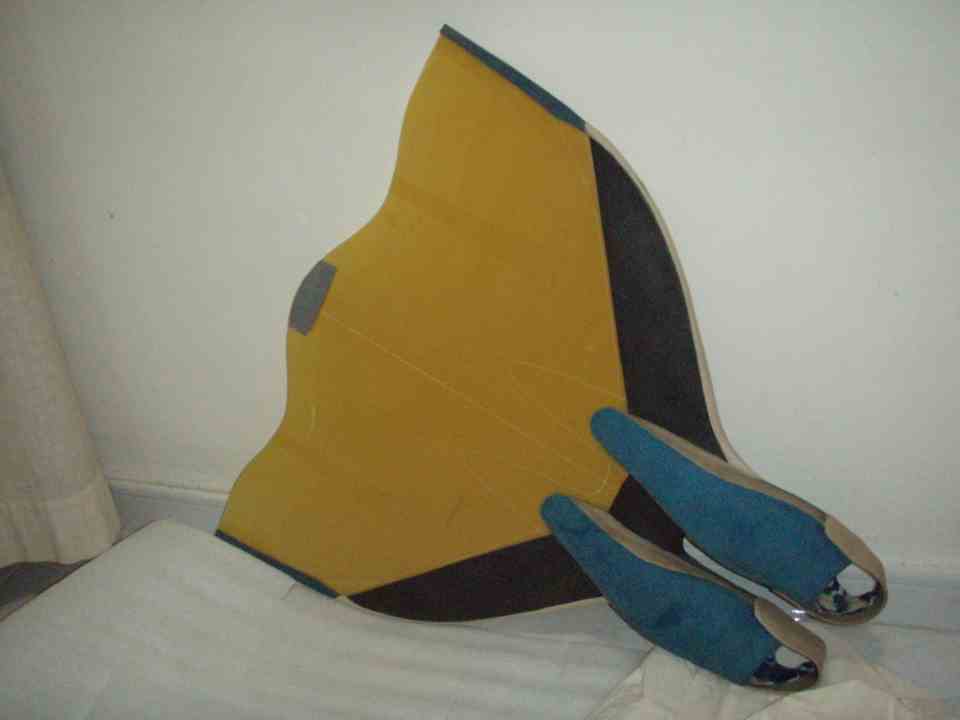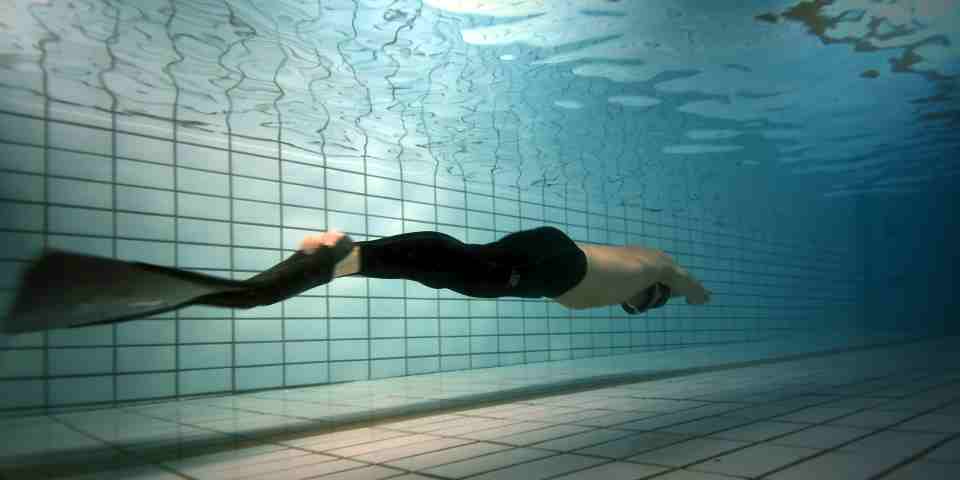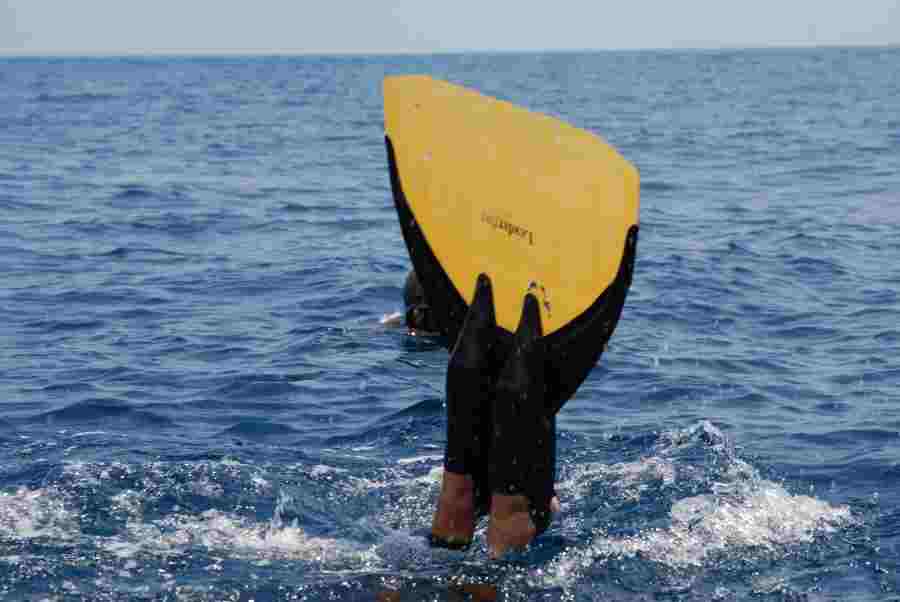- You are here:
- Home »
- Blog »
- Gear Guide »
- Freediving: Monofin Vs Bi Fins – Which Should You Use?
Freediving: Monofin Vs Bi Fins – Which Should You Use?


Freediving Monofin Vs Bi Fins: Let’s settle the debate once and for all.
If you’ve ever attended any sort of professional freediving championship, or dived alongside experienced freedivers; you’ll probably have seen the monofin before.
At first sight, the monofin looks strange, awkward and downright uncomfortable to wear.
This then begs the questions: Why do freedivers wear monofins? And how will your performance as a freediver differ when using a monofin vs bi fins?
Well, the key difference between a monofin vs bi fins; is that monofins are faster and more efficient for straight line freediving (up/down in the ocean or laps in a swimming pool). This makes monofins perfect for deep, competitive freediving and record setting. Bifins, on the other hand, are not as fast as monofins, but have better turn, maneuverability, are easier to use and best suited for recreational freediving & spearfishing.
Monofin vs bi fins: what do they look like?
Monofins: The shape of a monofin looks almost identical to a dolphin’s flipper. When wearing a monofin, both your feet are enclosed in the foot straps, so they won’t be able to separate when you kick. Also, your legs and thighs stay together the entire time you wear a monofin; meaning you’ll be using the dolphin kicking technique.

The monofin binds both your feet together in the one fin making turning difficult.
Bi Fins: Bi fins, as the name suggests, are two separate, unconnected fins. One for each foot. Also for the sake of this post, bi fins will refer to long-bladed freediving fins. When wearing bi fins, you’ll be able to separate your legs when kicking. For this reason, the main finning technique used with bi fins is the flutter kick.
If you’d like to know the best bifins and monofins to use in 2022, I’ve written a post with my recommendations – you can check it out by clicking this link here.
If you’re still on the fence trying to choose between a monofin vs a bifin, I’ve listed the advantages and disadvantages of each type of fin type below.
Pros of using a monofin
-
- Faster speeds with less effort: The dolphin flipper design of the monofin makes for devastatingly efficient power transfer with each kick. With much less kicking effort, you’ll find yourself gliding an extra 15% – 40% more in distance than you would with normal bi fins (this is often why professional freedivers prefer monofins). As you kick with the monofin, you should feel the blade ‘pop’ back into place. This spring-like action thrusts you through the water like a torpedo, making the monofin perfect for reaching incredible depths.
- Drastically cuts down water resistance & turbulence: Arguably, one of the greatest things about using a monofin, is that you’re forced to use the dolphin kick. Why is the dolphin kick so great? Well, because it naturally turns your body into an incredibly hydrodynamic shape – hands above your head at all times and torpedoing your way through the water via undulation.
The downside of the dolphin kick is that is quite difficult to learn by yourself, so try to find a trainer or coach to help you.
- Boosted breath-hold time: Another interesting benefit from dolphin kicking with a monofin is that the motion tends to relax your diaphragm muscles. More relaxed diaphragm muscles leads to less exertion on your lungs and better breath-holding.
- Increased stamina: The final cherry on top of using the dolphin-kick-monofin-combo, it that the fluid motion of undulating underwater skyrockets your stamina. Undulating helps spread your muscle exertion over multiple muscle groups…so you don’t get leg cramps and painful lactic acid burn build up in your legs.
- Hit record-breaking depths in straight line diving: If you’re doing competitive freediving where you descend or swim in just a straight line…you must have a monofin in your arsenal. Monofins allow almost any freediver with almost no experience in dolphin kicking, to comfortably add an easy 10m+ (~33 feet) to any straight line dive depth.

Monofins offer an incredbile amount of power in straight-line diving.
Cons of using a monofin
-
- Difficult to steer & turn with: One of the biggest drawbacks of using a monofin is that turning is quite difficult. Both your feet are bound and unable to separate, so it’s very difficult to adjust your swimming direction and maintain balance. You can only really go in two directions: up or down (or forwards/backwards in DYN).
- Poor for recreational diving: Monofins are perfect for advanced freedivers looking to push their limits and break records. But as mentioned above, it’s frustratingly difficult to master turning with a monofin. This really limits your recreational dives as you’ll only be able to swim in straight lines.
Also, monofins tend to be very wide in diameter. So if you’re the adventurous type that likes exploring wrecks, caves or do other recreational activities… you might struggle and get stuck with a big ol’ clunky monofin fin.
- Bad for spearfishing: Similar to the above point. Monofins can be tough to use in spearfishing, where typically you need to be quite agile and nimble in the water. You’ll find yourself struggling to keep up with fish in tight spots. Moving gracefully between rocks, weeds and coral will be a real challenge with a monofin.
- Dolphin kicking technique is difficult to learn: There isn’t a great deal of information out there on how to properly undulate and dolphin kick with a monofin. For that reason, it can take quite a while to learn how to use the monofin effectively. To counteract this, find a mentor or buddy who uses a monofin – this will greatly accelerate your dolphin kicking technique.
- Awkward to put on: One tiny flaw of monofins is how annoying they can be to put on. You can’t simply slip them on onshore or on the deck of the boat. You have to actually take them on and off while floating in the water. It can be irritating having to fumble around with straps while treading water – especially when there are waves!
- Expensive: The average monofin is more expensive than a pair of long freediving bi-fins. Also, monofins typically need to be purchased online as they are also much rarer to find in your typical dive shop.
- Difficult to travel with: The wide diameter of the monofin can be a real struggle to fit into your suitcase! You’ll also find yourself needing to use all sorts of special packages and treatment options for air travel.
- Can’t use your hands: The dolphin kicking technique that naturally works best with the monofin…requires your hands to be above your head the entire time. And what does that mean for you? Well, if you’re going to use a monofin…get ready to say good-bye to having full functional use of your hands. Oh, and taking pictures while diving is out of the question as well. Also…you better get a nose clip and start practicing your hands free equalization!
- Hard to stay still with: It’s near impossible to tread water and stay in the same spot when wearing a monofin. Your only other option is to lean your fin on the ground to stay still. This can be real annoying and detract from your freediving experience.
- Shore diving can be a pain: Holding your monofins in one hand while swimming your way out to your dive spot can be difficult. This is especially true if you’re combating against waves and strong currents.
Best Monofin
I recommend you invest in the FINIS Competitor Monofin. This monofin is no joke – its gigantic blade is 28″ by 28″ and literally torpedos you through the water.
Using the FINIS monofin – when compared to normal bi-fins – is like using a cheatcode in a video game…you’ll be shocked at how quickly and effortlessly it jets you down passed your record depths. (Click here to check the price on Amazon).
Pros of using bi-fins
-
- Simple to use: Using bi-fins is incredibly easy and intuitive. Any beginner should be able strap on some bi-fins and master the flutter kick quickly with near-perfect technique.
- Easy to steer with: Your feet aren’t bound together and are able to move around freely. With both feet separated, you can easily correct mis-turns and quickly change directions, making you all the more of an agile freediver.
- Great for beginners: The increased maneuverability & intuitive flutter kicking technique that comes from wearing bi-fins makes them very beginner friendly. Also, if you’re a beginner freediver, you’ll love how bi-fins are great for heavy surf entry, open water and unpredictable diving conditions.
- Cheaper & more common: Bi-fins as a whole are cheaper and easier to find in stores as opposed to monofins. Although do keep in mind…price does depend heavily on what material the blade is made from (eg: cheap plastic vs expensive carbon fiber).
- Fantastic for recreational diving & spearfishing: Bi-fins are very balanced in terms of what they offer you as a freediver. On the one hand they offer great maneuverability. On the other hand, they also have long, flexible blades which make for great speed. And to top it all off…you can easily squeeze into tight caves and cabins without having to worry about your fin blades getting stuck. These features make bi-fins the best go-to gear for leisurely freediving and spearfishing.

Prefer recreational diving? Grab a pair of bi fins for easier maneuverability!
- You can use your hands: When using bifins you’re able to look around, use your hands and stop to take photographs.
- Safer: As a safety diver or buddy diver, you should be wearing bi-fins. Not only do they let you comfortably tread water while keeping an eye on your buddy…they also let you use your hands and scissor kick back to safety if you need to carry an unconscious diver.
Cons of using bi-fins
- Less energy efficient: Using the flutter kick that comes naturally to bi-fins…burns a great deal of oxygen. In the long run, bi-fins will end up chewing more of your oxygen reserves with less underwater speed…than the monofin does. Don’t get me wrong though – long bladed freediving fins are still incredibly efficient. Much better than regular scuba or snorkeling fins. But if you want to break into the top 5% of energy efficiency and really maximize your oxygen conservation and hit deeper depths…you’ll eventually need to ditch the bi-fins for a nice pair of monofins.
- Not as fast: Bi-fins can still get you to incredibly fast speeds – especially if you’re using long fiberglass or carbon fiber blades. But at the end of the day, with bifins you’re using a less efficient kicking technique and blade design, which results in you leaving potential underwater speed & power on the table.
- Not your best pick for competitive diving: Bi-fins are weaker when it comes to oxygen conservation, efficiency and speed…when compared to a good monofin. So if you’re serious about being a professional freediver and want to hit maximum depths…how are you going to compete against a similar skilled freediver using a faster monofin? In this case, if you’re still using a bifin, it may be time to make the switch to a monofin.
- Less suitable for straight line diving: Just to be clear – you can absolutely do straight line diving with bi-fins. The only issue is that it’s likely less efficient than using a monofin. However, there are still some professional divers that strictly only use bi-fins…so it’s your call – try experimenting with both fin types and comparing results.
- More leg fatigue: When using bi-fins, you’ll mainly be finning with your hips and leg muscles. You’ll find the lactic acid build-up really start to burn when diving deep or frequently. Monofins on the other hand, utilize a dolphin kick technique to spread the workload over your legs, abdominal muscles and chest for better stamina and less muscle burn.
Best Bi-Fins
I recommend investing in the Gara Professional LD bi-fins. The reason I like the Garas so much…
Is because the blades have a unique elastomer-polypropylene blend.
This material blend unlocks all the normal powers of a bi-fin – turbo thrust and agility in the water…
While still having blades that are super soft and VERY easy to kick with (they don’t require big leg muscles).
In other words, you won’t get that annoying burning lactic acid feeling in your legs early on in your dive with these fins…Click here to check the price of the Gara Professional LD Cressi Fins on Amazon.
Monofin vs bi fin for freediving: and the winner is…
The monofin is the clear winner for any professional or advanced freediver looking to increase underwater time, maximize distance & hit huge depths. Almost all fin discipline freediving records have been set using a monofin. Notable disciplines monofins thrive in are:
- DYN (Dynamic Apnea With Fins): When doing DYN in a pool you swim in a straight line, have high visibility and you’re close to the surface. This means you don’t really need high maneuverability and speed is the name of the game.
- CWT (Constant Weight With Fins): For CWT: monofins are better. A monofin gives you more force to counteract positive and negative buoyancy experienced at great depths common to CWT.
If you are serious about competitive freediving, you’ll also need to invest in other high-quality gear like a good freediving computer that minimizes your chances of shallow water blackout…
And make sure you’ve got a RUBBER weight belt (NOT nylon)….
And lastly, invest in an Air Restriction Device if you aren’t already boosting your breath-holds with one…

Are you training to break a record? Get that extra competitive edge using a monofin.
For all other non-competitive freediving – eg: to enjoy the peace and quiet of the underwater realm, take amazing pictures underwater, explore underwater caverns, see the marine life or go spearing…
You’re better off going with a good pair of bi-fins. Freediving bi-fins (with long blades) are still incredibly quick and great for almost all other sorts of freediving activities.
Freediving finning techniques: monofin vs bi fin
Monofin finning technique: The dolphin kick.
Unsurprisingly, you’ll be using different finning techniques when switching from bi fins to a monofin.
The most common finning technique to use when wearing a monofin is the dolphin kick.
The dolphin kick involves stretching your arms above your head with your hands overlapping, like you’re about to dive into a pool. Your face should be pointing in the same direction as your palms. With each ‘kick’, you should be doing a full-body undulation.
When done correctly, the undulation of your dolphin kick uses your whole body. If someone was watching you from a side on view, your whole body should be seen gliding through the water smoothly and calmly in a fully-synchronized wave-like motion.
Below is a fantastic video found on Youtube (not my video!) of the dolphin kick with monofin in action:
Lastly, when learning the dolphin kick, it’s best to get a professional or an experienced buddy to teach you. This is the case for two reasons:
1) There are many different styles (eg: snaky/sprint etc) and you don’t want to mix up the techniques.
2)It’s very difficult to nail down the specifics in order to hit top speed. You’ll need someone to explain how to kick, the hydrodynamics involved, how to use your whole body in tandem, your kick size and speed, how to ride the glide, how to use your abdominals and so on.
If you want a more in-depth guide to using a monofin for the first time, I recommend reading this guide here.
Bi-fin finning technique: The flutter kick
The best and most common finning technique for bi-fins is the flutter kick.
The great thing about the flutter kick is how easy and effortless it is to learn. With minimal training and almost no effort…you can easily master the flutter kick and start motoring through the water at a reasonably fast pace.
To see the flutter kick in action, watch the short 34 second video below by a Youtube contributor (not my video):
https://www.youtube.com/watch?v=N693LINxGZc
See how simple it looks? Well, it looks simple because it is. There isn’t exactly a great deal of complexity to the flutter kick.
Despite this, I think there are still 3 common mistakes beginners make with the flutter kick:
1. They kick too far behind themselves and not far enough in front: Instead, you should be kicking evenly both in front of your body and behind your body. Make sure your legs come out as far in front of you, as they go out behind you.
2. They bend their legs when kicking: Make sure you keep your legs almost completely straight when finning. A slight bend is fine, but don’t go over the top, otherwise you’ll lose power from your kick and steer yourself at a diagonal angle away from your rope.
3. They don’t kick from the hip: When you fin, almost all the force and power should be sourced from your hips.
About the Author Gerrie van Niekerk - Apnealogy
Gerrie is a passionate Freediver, Spearfisher, Digital Marketer, and author for the Apnealogy website. Gerrie is an SSI Level 1 certified Freediver who loves geeking out about freediving and spearfishing gear and lives for his family and adventure.


